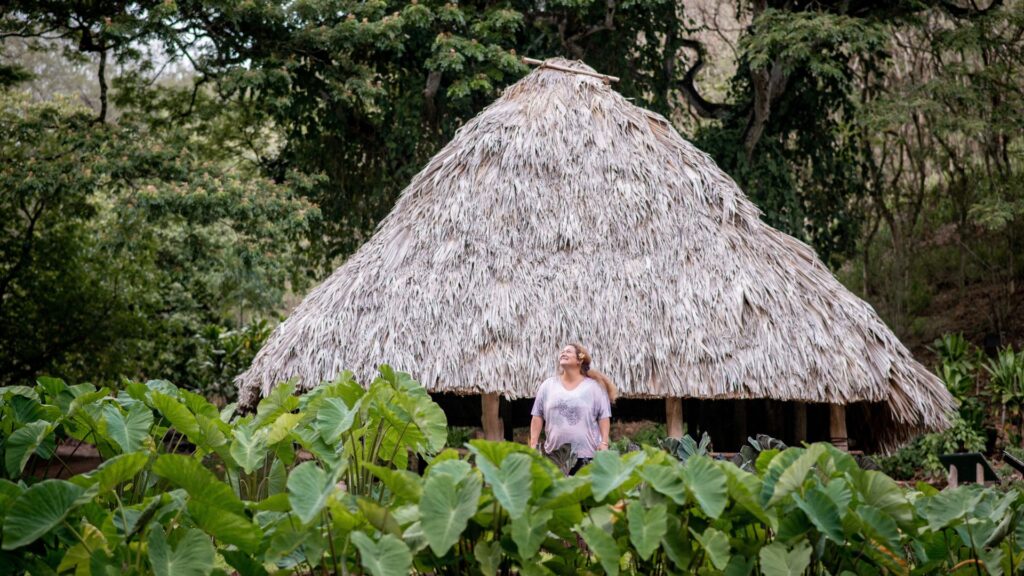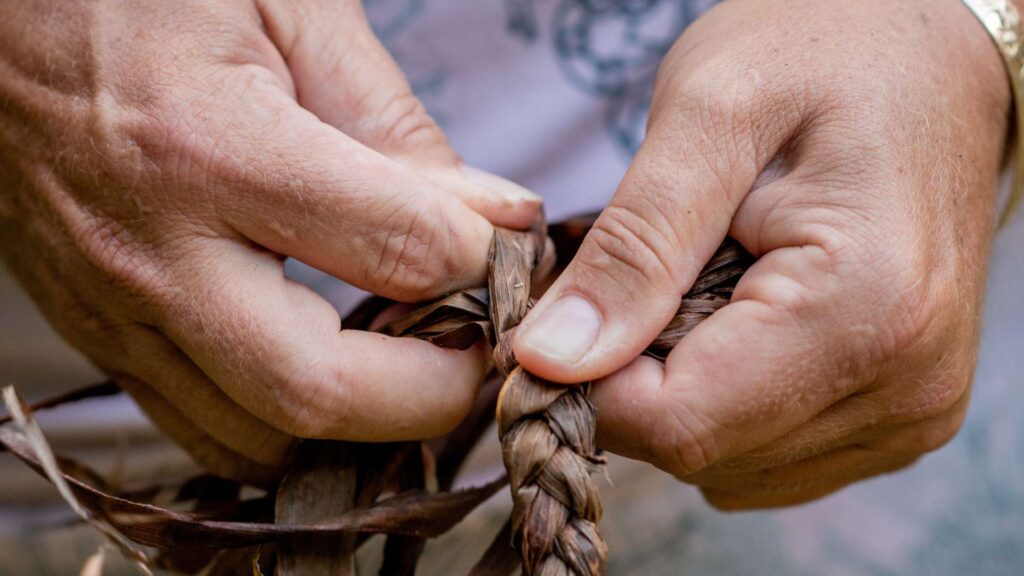People need plants. They are the root cause of our health, habitat, and happiness. More than ever, plants need you. Join us this fall as we explore how cultivating deeper connections with plants can grow a brighter tomorrow for our ecosystems and communities.

Lei Wann, Director of Limahuli Garden & Preserve, happy amongst the kalo (taro)
Think of your happy place—a location or memory that you recall fondly—and I bet plants are in the picture. Maybe they define the surroundings of a cherished moment. Maybe they’re on the plates of a meal shared with loved ones. Maybe plants are your happy place: a beloved tree, garden, or landscape that fills you with joy. The root cause of happiness, it turns out, is often plants.
Hawaiian lei are the epitome of plant joy. A master lei maker is a matchmaker. With devotion, the lei maker weaves together the right plants for the right person. Some lei, like those crafted with hundreds of ʻilima or kou blossoms, are a labor of love. As the soon-to-be-recipient of the lei dreams in the quiet dawn, hundreds of petals are gathered. As the recipient begins to wake, hands begin to weave the lei together, each blossom strung with utmost care. As the recipient’s day progresses hour by hour, the lei grows flower by flower. At just the right moment, the lei maker and the recipient come together. The gift that is given is a pure expression of aloha. The lei encircles them in a love that only the lei maker, and the specific harmony of woven plants, can provide. It is hard to imagine a smile bigger, a smile warmer than when one receives a lei.
(L) Fern Lab Technician Emily Sezate presents a fern lei. (R) Limahuli’s Department Administrator & Volunteer Coordinator Angelina Kissida strings a plumeria lei
Plants make us happy, everywhere. Remarkably, it seems that plants help us express our most human emotions. Gifts of flowers, like lei, are a timeless way to communicate our deepest feelings. Indeed, plants guide many of our cultural and spiritual practices. Hula, a revered dance described by King David Kalākaua as the “heartbeat of the Hawaiian people,” is inextricably rooted to the plants of Hawaii. Plants can be both muse and material. In addition to representing plants in virtually every media, artists throughout time have drawn, painted, woven, sculpted, carved, and dyed with plants. Without plants, the world would be lifeless in many definitions of the word. Across tropical regions and throughout the world, plants make life happier.

Lei Wann begins weaving a kī (ti) leaf lei
Watching Lei Wann, Director of Limahuli Garden & Preserve, make lei is as mesmerizing as the beautiful plants she uses. Her hands know each flower, frond, fruit, and seed on a profound level. “For me, many plants have deeper connections to my heritage and culture. Being with them or working with them is like being with an ancestor. It’s like being with family.”
Her lei braids together generations of people and plants. Woven into every lei is a heritage of the artform itself as well as the moʻolelo (stories) behind each plant. Like the cord that holds the lei together, an inseparable connection to the ‘āina (land) threads everything together. Her intimate knowledge of plants, and their inherent meanings, guides her process as she makes lei for friends new and old.
“For me, plants have deeper connections to my heritage and culture. Being with them or working with them is like being with an ancestor. It’s like being with family.”
Lei Wann, Director of Limahuli Garden & Preserve
Lei loves to teach traditional plant practices like lei making. “By teaching these plant practices, I am keeping my culture and traditions alive. When you engage in plant practices, you are making deep connections with plants. You are interacting with them and getting to know them on a deeper level.” Nurturing community connection to the ‘āina is a key part of Limahuli’s approach for restoration. Lei leads the stewardship of Limahuli Valley and Preserve with an ahupuaʻa frame of mind: that ecosystem restoration is fundamentally tied to community restoration.
Two of Lei’s favorite plants are laua’e o Makana and pāpala. “For generations, these plants were used to reference our place and people. Laua’e can also be a metaphorical way of speaking of the sweet and cherished people of Haena. Pāpala is part of the famous art of ʻōahi (fire throwing ceremony) of which my ancestors were famous. Pāpala can also metaphorically speak of love and aloha.” Revitalizing plants revitalizes culture. Laua’e and pāpala, among many other invaluable plants, are grown at Limahuli to ensure that ancestral traditions continue.
As family members, as gift givers, as culture keepers, plants make Lei happy. “They bring life and goodness into the world, and for that I am humbled and happy to be in their presence.”

Volunteer Leslie Ridpath tending to endangered plants in the Conservation Nursery
For NTBG volunteer Leslie Ridpath, gardening is a wellspring of joy and restoration. “I find that my garden gives me a creative outlet. I really enjoy using the color and structure of the plants in a variety of combinations creating different distinct areas. Unlike a painting, there is constant change in a garden.”
When Leslie relocated to Kauai, she began volunteering at NTBG to “learn about the plants that do well in this environment to help me in designing my own garden.” By volunteering across departments, she drew connections between cultivating plants and making a positive impact for our local environment. “I love to learn new things and as I have volunteered in various roles at NTBG, it has really helped to get the bigger picture of what they are trying to accomplish in their mission. By volunteering at NTBG, I’ve had the chance to work with endangered plants, including a study that looks at the impacts of climate change on coastal plants. I find this very rewarding.”
Plants provide Leslie with the inspiration and opportunity to make a difference in her community. By growing plants native to your region, you can too! Native plants provide a refuge for wildlife, are environmentally friendly, and celebrate the beauty unique to your home. For Leslie, growing plants in her garden and as a volunteer at NTBG provides a perennial source of happiness.
(L) Lei Wann gathers a kī (ti) leaf to make lei. (R) The hale (house) nestled in Limahuli Valley
So much happiness is rooted in plants. They nourish our bodies and feed our souls. They tie generations together, keeping culture alive. Plants also help us share the love. By growing plants, we can cultivate a better world for our families, communities, and ecosystems. What could bring more joy than that?
Plants nourish our ecosystems and communities in countless ways. When we care for plants, they continue caring for us. This giving season, help grow a brighter tomorrow for tropical plants.